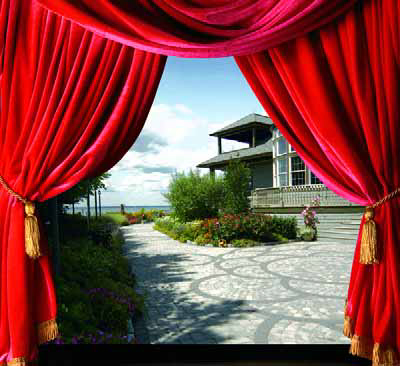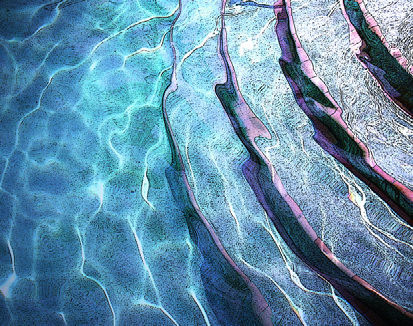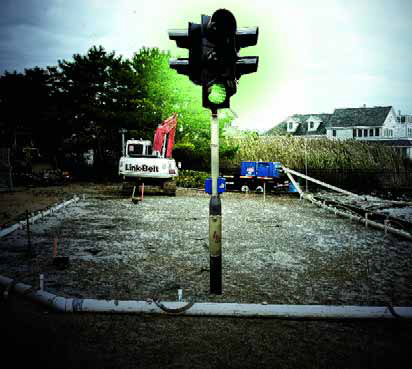details
Every year, it seems, I'm asked to teach more and more classes on how to build streams, waterfalls and ponds that look natural. I enjoy conducting these sessions for local supply houses, landscape architecture firms, community colleges and other organizations and find it flattering that they value what I know. My motivation for sharing, however, is less about ego gratification than it is about my awareness that there's no way a single company can build all of the naturalistic watershapes consumers want these days. To me, it's a matter of collective as well as personal interest that these watershapes be built to function well and look great. In Colorado in particular, I also see a need for work that appears completely and distinctly natural, simply because most clients here are accustomed to seeing remarkable beauty in the countless alpine settings that grace this beautiful state. Indeed, it's a fact of professional life here that the work must mimic nature closely or it just won't fly. That can be very good for business, of course, but only if more than a few professionals hereabouts are up to the challenge. Available projects range from those that use thousands of
When I first entered the watershaping industry in the late 1970s, one of the details to which I took an immediate dislike was the practice of wrapping the tile that covered the walls of raised bond beams around the corner and onto step risers and various other vertical hardscape surfaces found around pools and spas. We've all seen it - Spanish Colonial Revivalist tiles of questionable authenticity, extra-bold in color and used to cover highly visible vertical surfaces. To me, these swaths invariably look out of place and have the effect of drawing attention to features that often don't warrant or benefit from the emphasis. It happens to this day because
As landscape professionals, most of us seek not only to innovate and drive the industry to new levels, but also endeavor as necessary to learn about basic design principles and styles that have inspired and ignited design movements in past centuries. By studying the range of architectural and landscape styles that have gone before us, we learn to use historical cues to guide us in our current tasks. At the same time, our knowledge of what was done in the past positions us to develop variations on themes and do things
It often happens that the way people enter a space has everything to do with the way they experience it and come to regard its overall design. This was much on my mind as we concluded our work on the Long Beach Island project I've discussed in my last few "Details." By orchestrating access and movement toward the backyard/pool area, we developed a string of transitions that lend a sense of surprise and delight to those entering a beautifully designed and constructed space that literally seems like a world apart. As discussed in previous columns, the backyard features a
In a couple of my recent "Details," I've discussed the early stages of a wonderful project located on the waterfront of Long Beach Island, N.J. As is the case with many top-level jobs, this one required a great deal of work in the early going to make sure we were set up for complete success once the installation process was under way and the pool, spa and surrounding structures began to come together. Although the pool in question is a simple rectangle designed to function mainly as a subtle and elegant reflective surface, there are certain features within the "shape" of the shell that make it something special - and particularly relevant to how the clients
Sometimes the simple things make all the difference between success and failure. For all of the high-flown conceptualizing that drives much of what so many watershapers do these days, there's no escaping the need for attention to
In the design and construction of any watershape, there are a number of points in the process where you can see big differences between the way custom designers and contractors do things and the way production/volume-oriented companies go about their business. From first conversations with clients straight through to commissioning the system and turning it over to the homeowners, it's easy to spot these distinctions and define key differences. To illustrate just one of these areas, let me discuss the case of the permitting phase for the project on Long Beach Island, N.J., I began covering two issues ago. What's involved here is a cluster of issues that occurred more or less simultaneously in the project's early going. The elements of this cluster may not seem directly related to one another, but
In last month's "Detail," I discussed the beginning stages of a new project that has my partner Kevin Fleming and me pretty excited. At this point, the pool's been shot and we're moving along at a good pace. I'll pick up that project again in upcoming issues, but I've brought it up briefly here to launch into a discussion about something in our industry that mystifies me almost on a daily basis. So far, the work we've done on the oceanfront renovation project has been focused on a relatively narrow band of design considerations having to do with the watershape and its associated structures. This focus is
Think of it: Just below the surface of our ponds and streams is a wonderful potential for beauty, an amazing opportunity to open observers' eyes to an entire submerged "landscape" made possible by virtue of completely clear water. I like to picture it as an "underwater garden," which is why, to me, water clarity is an essential component of my ponds and streams. Too often, however, I run into settings in which it simply has not been a priority for the designer or installer. I'm further distressed when the subsurface views I treat as key design elements are left partially or wholly unconsidered. I think back to my family's trips to the seashore, where we would spend hours observing rocky tidal pools. Peering into the water and seeing a world of oceanic plants and animals at close proximity was a profound source of fascination and excitement. It is for me still – and, I believe, for most other people as well. What I see in tide pools is a perfectly balanced, utterly natural underwater garden filled with beautiful stone colors, textures weathered by the action of the waves and tides and a plethora of pebbles and sand mixed with bits of seashell. It is here that we may
Beginning a project can be wonderfully exciting, especially when you're working in a beautiful place with a terrific client who wants something truly elegant and special. In fact, I can honestly say that there's nothing quite like the exhilaration of stepping into a new situation with great potential, defining those possibilities and watching a client's eyes light up with the fire of inspiration. Case in point: Not long ago, my partner Kevin Fleming and I were called out to a job site on Long Beach Island, N.J., by local landscaper Mark Reynolds, who'd heard of us and our reputation for using top-quality materials in top-flight designs. When we pulled up, the first thing I noticed was the






















